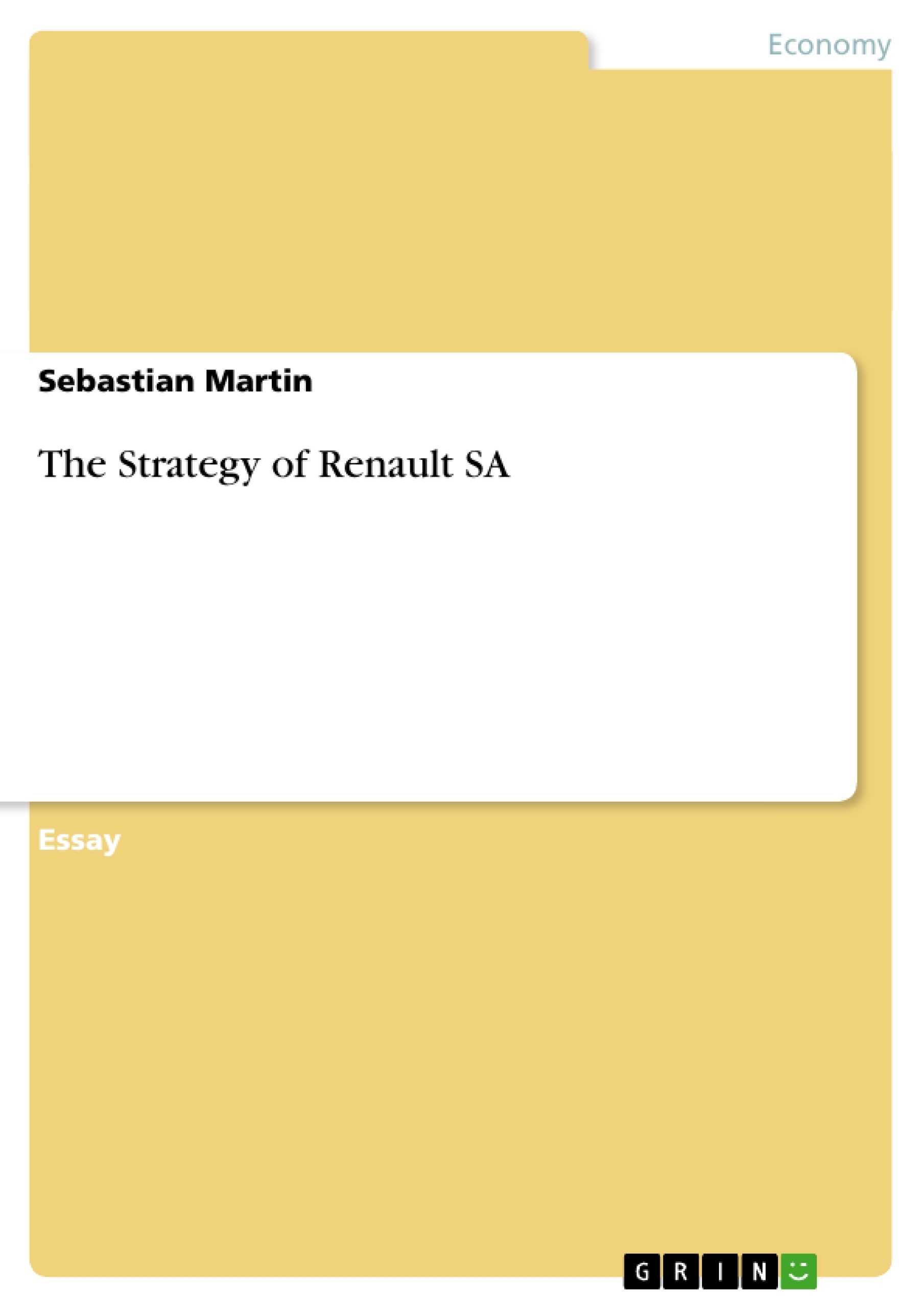This assignment paper will describe Renault’s current competitive strategy and competitive advantage. It will be explained why the strategy has been adopted and which impact it has towards the companies recent performance. Moreover, recommendations for its future strategy shall be provided. Closer information concerning Renault is mentioned in the appendix.
Table of Contents
1.) Introduction
2.) Resources and capabilities of Renault SA
2.1) Resources:
2.1.1) Tangible Resources
2.1.2) Intangible Resources
2.2) Capabilities:
3.) Competitive strategy and advantage of Renault SA
4.) Explanation why the current strategy has been adapted
5.) Evaluation of the strategy in terms of its impact on the company’s recent performance, current position and likely future prospects.
6.) Considered recommendations for the future strategy
References
Appendices
List of Figures
Figure 1: Industrial Accidents
Figure 2: Value Chain of Renault
Figure 3: The links among Dacias resources, capabilities, and competitive advantage
Figure 4: Strategic Groups
List of Tables
Table 1: Dept/ Equity ratio of Renault
Table 2: Net profit, in million €
Table 3: Operation margin
Table 4: Some awards of RENAULT cars
Table 5: Growth in sale
List of Appendices
Appendix 1: About Renault SA
Appendix 2: Agreements & cooperations
Appendix 3: Primary production sites
1.) Introduction:
This assignment paper will describe Renault’s current competitive strategy and competitive advantage. It will be explained why the strategy has been adopted and which impact it has towards the companies recent performance. Moreover, recommendations for its future strategy shall be provided. Closer information concerning Renault is mentioned in the appendix.
2.) Resources and capabilities of Renault SA
2.1) Resources:
2.1.1) Tangible Resources:
Financial Resources:
Since 2000, Renault tremendously decreased its debts. (Table 1) Still 2003, Renault’s net profit amounted more than twice the net profit of Volkswagen.(Table 2) The first half of 2004, Renault achieved a operation margin of 6.1%, exceeding Volkswagen and Peugeot Citro n.(Table 3) All together, Renault seems to have strong financial resources.
Table 1: Dept/ Equity ratio of Renault Source: author 2005
illustration not visible in this excerpt
source: Renault 2004
Conclusion
Shows that in 2003 Renault had less total liabilities in comparison with total equity than in 2001. This can be seen as good development. Renault decreased the Ratio number by nearly two third.
Table 2: Net profit, in million € Source: author 2005
illustration not visible in this excerpt
Table 3: Operation margin Source: author 2005
illustration not visible in this excerpt
Source: (Katzensteiner T. &
Physical Resources:
Renault manufactures cars in more than 30 sites world wide and is able to use facilities of other manufacturers, like Matra plants as well as the site of GM Europe in the Uk, through operative cost-sharing agreements. The 1999 formed Alliance with Nissan let Renault use additionally facilities such as in Mexico. Some suppliers even opened facilities next to some of Renault’s plants.(Renault 2004) Please see appendix 3 for more detail.
2.1.2) Intangible Resources:
Technological Resources:
The in table 4 listed awards show that Renault has decent technological resources. For example did the Espace recently achieve the “highest score ever recorded in independent crash tests by Euro NCAP” (carpages.co.uk). Between 2002 and 2003, additionally Renault’s patents increased by 18.22 per cent. Renault’s R&D Ratio decreased from 5.6% in 2001 to 4.9% in 2003. (Renault 2004, 144)
Table 4: Some awards of RENAULT cars
Source: author 2004
illustration not visible in this excerpt
Reputation:
Beside itself as “leading brand in Western Europe in all the passenger and light commercial vehicle markets” (Deloitte Touche Tohmatsu 2004), Renault has majority shares in two other brands: Dacia and Samsung. Renault, with around 100 as well as Dacia with more than 40 years have a long tradition and reputation as car manufacturers. (glaubeaktuell.net 2004; Renault 2004)
Human resource:
Training, health and safety of employees are seen as important by Renault. 360° feedback as well as surveys is used to measure and improve the staff performance. (Renault 2004) Figure 1 indicates improvements in the human resource sector. The number of industrial accidents with time off decreased between 2000 and 2003.
Figure 1: Industrial Accidents
illustration not visible in this excerpt
Source: Renault 2004, PAGE 113
2.2) Capabilities:
Renault is strong in competing in price and innovative design (Dobson P. 2004). How design can boost profit and sales can be seen in the success of the Renault Megane(Dawson C. 2004, page 39-40). With its after-sales customer service, additionally Renault tries to improve the loyalty of its clients to ensure that existing clients will also buy Renault in future. (Deloitte Touche Tohmatsu 2004). The Alliance with Nissan allows Renault cost cutting through sharing production capacity. Also Renault and Nissan are working jointly on advanced research and engineering. Industrial supplier parks next to some of Renault’s production places contribute to the inbound logistics. (Renault 2004; Automobilwoche (2004c) Renault made many Agreements & co operations over the last years. These will allow Renault to for example manufacture its Logan in Morocco and Iran as well as its Kangoo in Malayia.(Renault a)
Figure 2: Value Chain of Renault
illustration not visible in this excerpt
Source: author 2005 regarding Recklies D. 2001
[...]
- Quote paper
- Sebastian Martin (Author), 2005, The Strategy of Renault SA, Munich, GRIN Verlag, https://www.grin.com/document/42861
-

-

-

-
Upload your own papers! Earn money and win an iPhone X. -

-
Upload your own papers! Earn money and win an iPhone X. -

-
Upload your own papers! Earn money and win an iPhone X. -

-
Upload your own papers! Earn money and win an iPhone X. -

-
Upload your own papers! Earn money and win an iPhone X. -

-
Upload your own papers! Earn money and win an iPhone X.

